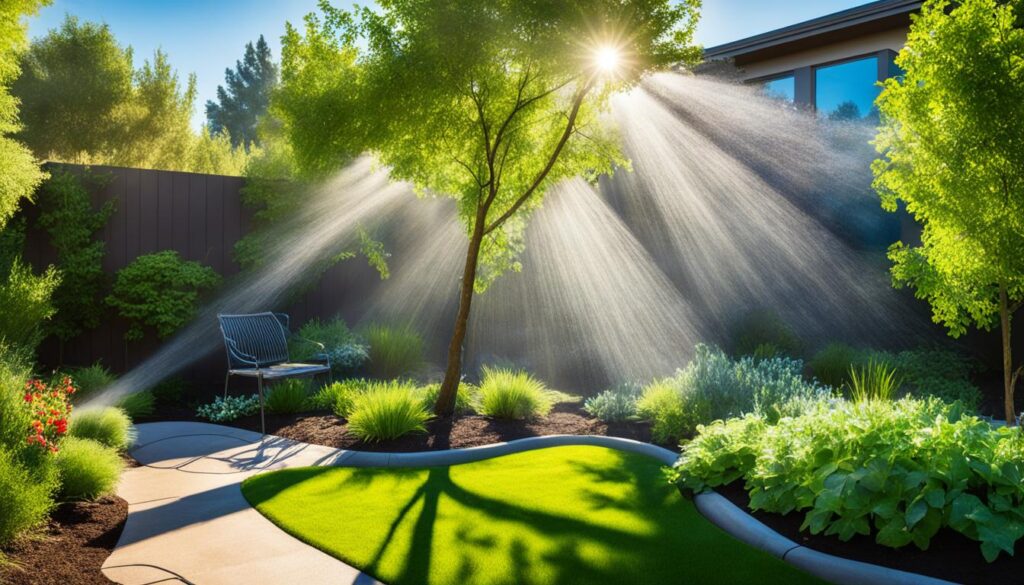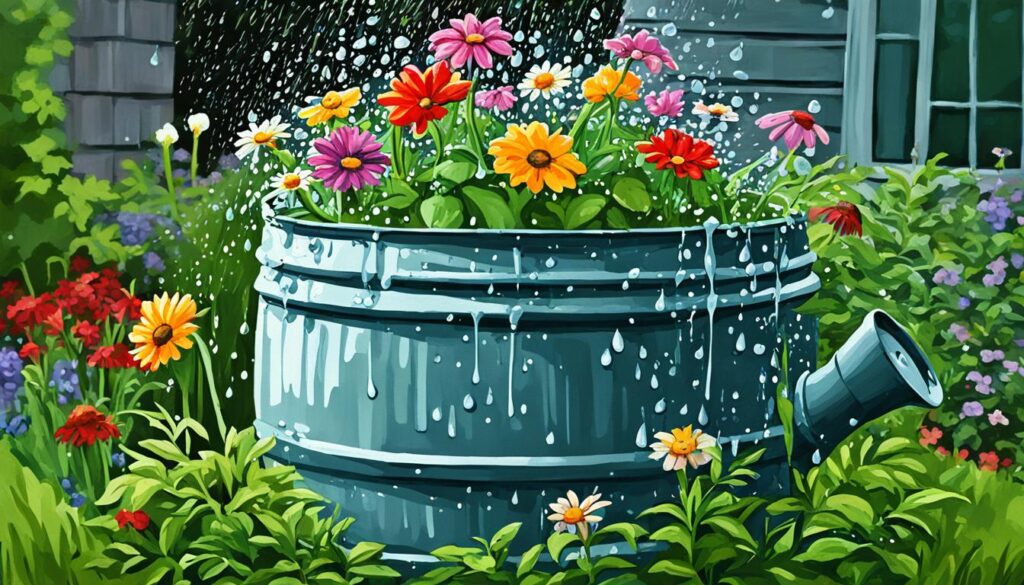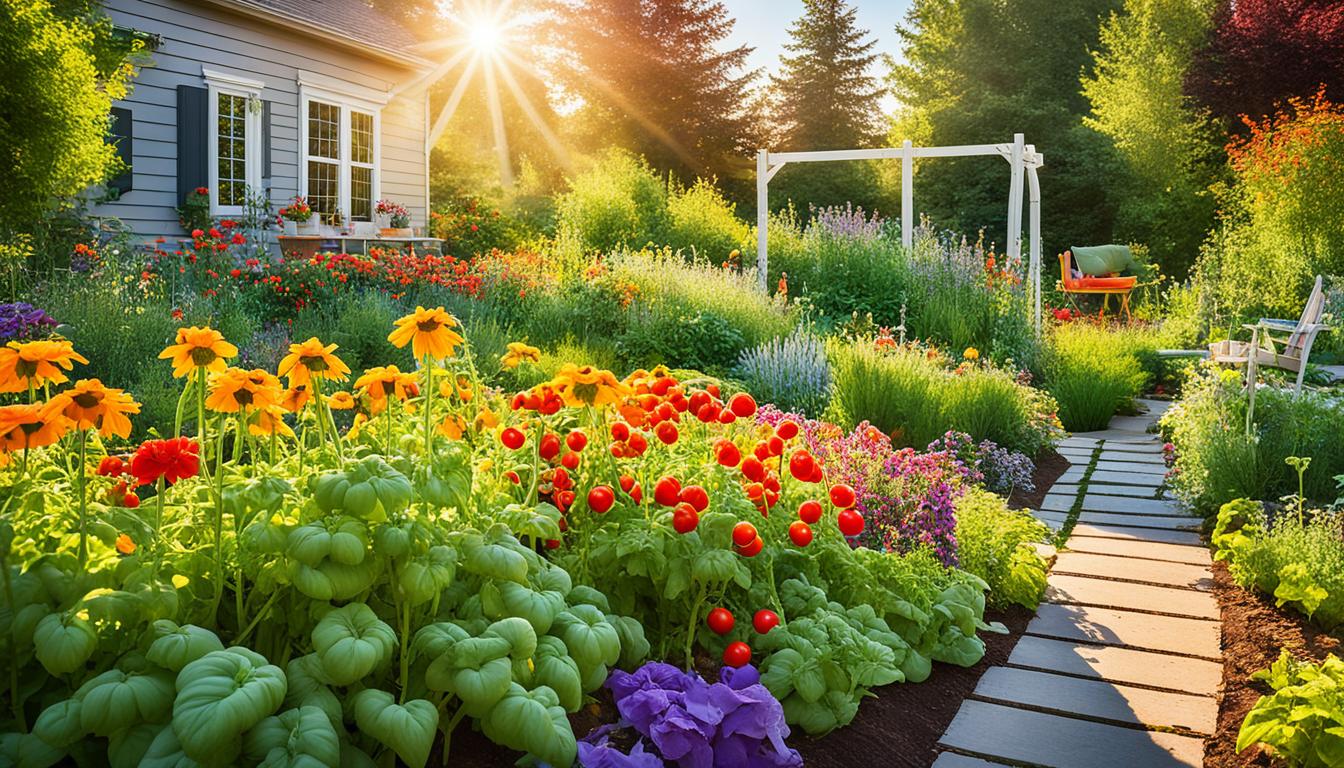This post contains affiliate links.
As the sun shines brighter and the days grow longer, there’s something magical about stepping into a garden in the summertime. The vibrant colors, the delicate fragrance of blooming flowers, and the gentle rustling of leaves in the warm breeze create a paradise of tranquility and beauty.
For me, gardening is not just a hobby; it’s a way to connect with nature and create a haven of peace and serenity right in my own backyard. But let’s face it, the scorching heat and relentless sunshine can put a strain on even the most dedicated gardener. That’s why I’ve put together these summer gardening tips to help you navigate the challenges and create a lush oasis that will make you the envy of the neighborhood.
Summer gardening is all about finding the right techniques and using the best plants to thrive in the hot weather. It’s about nurturing your garden with care so it can burst into a symphony of colors and maintain its health throughout the season. With these summer gardening ideas, you’ll be equipped to create a backyard paradise that will make you proud.
Drench Your Garden in Color
Transform your garden into a vibrant oasis by planting summer annuals that thrive in the heat. Say goodbye to faded spring blooms and welcome a burst of color with these stunning varieties:
Ageratum
Add a touch of blue to your garden with ageratum, a compact plant known for its fluffy flower clusters. These charming flowers are perfect for borders, containers, or as ground cover.
Pentas
Brighten up your garden with pentas, also known as Egyptian starflowers. With their clusters of star-shaped flowers in vibrant shades of red, pink, and purple, these plants are a magnet for butterflies and hummingbirds.
Zinnia
Zinnias come in a wide range of colors and shapes, making them a versatile choice for any garden. Their bold and cheerful blooms will fill your garden with joy throughout the summer.
Angelonia
Angelonia, also known as summer snapdragon, is a heat-tolerant annual that produces spikes of flowers in shades of pink, purple, and white. These delicate blooms add a touch of elegance to your garden.
To ensure a colorful display year after year, consider planting summer blooming bulbs. These bulbs, once planted, will reward you with vibrant blooms that burst forth season after season. Some popular summer blooming bulbs include:
- Dahlias
- Gladiolus
- Lilies
- Calla lilies
Bring life and vibrancy to your garden with these beautiful summer annuals and blooming bulbs. Your garden will be the envy of the neighborhood, providing a stunning display of color all summer long.
Protect Your Grass
To maintain a beautiful landscaped look, it’s important to take care of your grass and ensure it stays healthy throughout the summer. One key aspect of grass care is maintaining the proper length to protect it from the scorching sun. If your yard has cool-season grasses like ryegrass, fescue, or Kentucky bluegrass, there are some steps you can take to keep it in top condition.
Firstly, consider raising your mower blade to maintain a longer grass length. This will provide more leaf surface, which helps shield the grass from the intense heat. By leaving the grass a bit taller, you’ll create a natural shade that protects the soil and helps it retain moisture.
Another important factor to keep in mind is the type of grass you have. Cool-season grasses, such as ryegrass, fescue, and Kentucky bluegrass, have different growth patterns and requirements compared to warm-season grasses. It’s crucial to understand the specific needs of your grass type to ensure optimal care.
If you’re unsure about the ideal grass length or the specific care requirements for your cool-season grasses, consider consulting with a local lawn care expert or contacting your cooperative extension service for guidance tailored to your region. They can provide invaluable advice on maintaining the right grass length and ensuring optimal health for your lawn.
Remember, a little extra attention to your grass can go a long way in maintaining a lush, vibrant lawn all summer long.
Spread a Nice Layer of Mulch
In the scorching heat of summer, protecting your garden and keeping your plants healthy can be a challenging task. One effective method to combat the summer sun and maintain optimal growing conditions is to spread a nice layer of mulch over your garden beds. Mulching not only enhances the appearance of your garden but also offers numerous benefits for your plants.
When you spread mulch, make sure to apply a 2-inch thick layer. This depth provides adequate coverage and allows the mulch to effectively protect the soil from the sun’s intense rays. With a thick layer of mulch acting as a natural barrier, the soil retains moisture and stays cooler in hot weather. As a result, your plants’ roots are shielded from excessive heat, ensuring their health and vitality throughout the summer season.
By spreading mulch, you create a suitable environment for your plants to thrive. The mulch acts as a protective blanket, keeping the soil moist and preventing evaporation. This helps to conserve water, reduce the frequency of watering, and save you time and effort in maintaining your garden. Additionally, the mulch layer inhibits weed growth by blocking sunlight and suffocating weed seeds. Say goodbye to the tedious task of weed removal and hello to a more enjoyable gardening experience.
Furthermore, mulching provides insulation for your plants’ roots, keeping them at a stable temperature and protecting them from extreme heat. This insulation ensures that your plants can absorb nutrients efficiently and stay healthy even during hot spells. So, spread mulch generously around your garden to keep your roots cool, happy, and thriving.
Remember, mulching is a simple yet highly effective technique to protect your soil from the sun and provide essential nourishment to your plants. Take advantage of this easy and beneficial method to maintain a lush and vibrant garden all summer long.
| Benefits of Mulching in Summer |
|---|
| Protects soil from the sun’s intense rays |
| Retains moisture, reducing the need for frequent watering |
| Controls weed growth by blocking sunlight |
| Insulates roots, ensuring optimal nutrient absorption |
Image:
Deadhead Your Spring Blooms
Spring is a magical time in the garden, with flowers bursting into bloom and adding vibrant colors to your outdoor space. However, as the season progresses, some of these blooms start to wither and fade. To maintain the vibrant color and vitality of your garden, it’s important to deadhead your spring blooms.
Deadheading is the process of removing the spent flowers from your plants. This not only enhances the overall appearance of your garden but also has several other benefits. By deadheading, you stop the seed production of these fading blooms, allowing the plant to redirect its resources elsewhere.
“Deadheading allows the plant to allocate its resources to the remaining healthy blooms, ensuring that they continue to thrive and maintain their vibrant color for a longer period of time.”
Deadheading also prevents the plant from expending energy on producing seeds. This energy can instead be used for growth and the development of new buds. So, by removing these fading blooms, you are essentially encouraging the plant to put more effort into producing fresh, healthy flowers.
When deadheading, ensure that you remove the entire flower head, including any developing seeds. Use a pair of clean, sharp pruning shears or scissors to make a clean cut just above a healthy leaf or bud. This will not only promote new growth but also help to maintain the overall shape and structure of the plant.
Remember, deadheading is not only limited to spring blooms. It’s a practice that can be applied to various plants throughout the growing season to encourage continuous flowering and maintain a beautiful garden. So, grab your shears and start deadheading those spring blooms to keep your garden looking fresh and vibrant!
Timing and Strategies for Summer Watering
When it comes to watering your garden in the summer, timing and strategy are key to maintaining healthy plants and conserving water. In this section, we’ll explore some smart watering techniques to keep your garden thriving even in the hottest months.

Watering Timing
Choosing the right time of day to water your plants can make a significant difference in their overall health and water efficiency. The best times for summer watering are early morning or late evening when the sun is not at its peak.
Watering in the early morning allows the water to penetrate the soil deeply before the heat of the day evaporates it. This helps ensure that your plants receive the moisture they need to thrive.
Alternatively, watering in the late evening allows the foliage to dry before nightfall, reducing the risk of fungal diseases. It also gives your plants a chance to absorb the water overnight and prepare for the next day’s heat.
Deep Watering
Deep watering is a technique that encourages plants to develop strong and resilient root systems. Rather than watering shallowly and frequently, it’s better to water deeply and less frequently.
When you water deeply, the moisture reaches deep into the soil, prompting the roots to grow deeper in search of water. This not only helps plants access water during periods of drought but also makes them more resistant to heat stress.
Soaker Hose and Drip Irrigation System
Incorporating efficient watering systems like soaker hoses or drip irrigation systems can greatly improve water distribution and reduce water wastage.
A soaker hose delivers water directly to the base of your plants, minimizing evaporation and ensuring that the moisture reaches the root zone. This method is particularly effective for vegetable gardens and flower beds.
A drip irrigation system, on the other hand, uses a network of tubes and emitters to slowly release water to individual plants. This precise method prevents water runoff and provides targeted hydration to each plant.
Mulching
Mulching is an essential practice for maintaining soil moisture and reducing weed growth in the summer. Applying a layer of mulch around your plants helps retain moisture, keeping the soil cool and preventing evaporation.
Additionally, mulch acts as an insulating layer, protecting plant roots from extreme temperatures. Organic mulch, such as wood chips or straw, also breaks down over time and enriches the soil with nutrients.
“Smart watering strategies like timing, deep watering, and using efficient watering systems can make a significant difference in the health and water efficiency of your garden.”
By implementing these smart watering strategies and taking advantage of technologies like soaker hoses and drip irrigation systems, you can optimize your watering routine and ensure your plants stay hydrated and healthy even during the hottest summer months.
Next, we’ll dive deeper into the importance of mulching and how it can benefit your garden in Section 7.
The Importance of Mulching
When it comes to maintaining a thriving garden, mulching is a secret weapon that every gardener should have in their arsenal. Mulching with organic materials like wood chips, straw, or compost offers a myriad of benefits that will elevate your gardening game to the next level.
First and foremost, mulching helps retain soil moisture, keeping your plants hydrated and healthy even during scorching summer days. It acts as a protective barrier, shielding plant roots from the intense summer sun, preventing moisture from evaporating too quickly. With proper mulching, you can say goodbye to dry and thirsty plants.
Another advantage of mulching is its ability to reduce weed growth. By creating a barrier between the soil and the outside world, mulch inhibits weed seeds from sprouting and competing with your plants for vital nutrients. Say goodbye to endless weeding sessions and hello to a more manageable garden.
But that’s not all—mulching also helps regulate soil temperature. During hot summer days, the soil can heat up rapidly, which can be detrimental to plant roots. However, the layer of mulch acts as insulation, keeping the soil cooler and preventing extreme temperature fluctuations. Your plants will appreciate the stable and comfortable environment.
So, how exactly do you get started with mulching? It’s simple—just spread a generous layer of your preferred organic mulch around your plants, making sure to leave a small gap around the base of each plant to prevent rot. Whether you choose wood chips, straw, or compost, the key is to apply a layer that is at least 2-3 inches thick for optimal results.
Remember, mulching is a gift that keeps on giving. Not only does it enhance the aesthetics of your garden, but it also promotes plant health, conserves water, and reduces the amount of time you spend on maintenance. So why wait? Grab your mulch of choice and give your garden the love and care it deserves.
Benefits of Mulching:
- Retains soil moisture
- Reduces weed growth
- Regulates soil temperature
“Mulching is like giving your garden a cozy blanket—it keeps the soil moist, the weeds at bay, and the temperatures just right.”
– Gardening Guru
Monitoring Soil Moisture and Smart Watering Techniques
Proper watering is crucial for maintaining a healthy and thriving garden. Monitoring soil moisture levels and employing smart watering techniques will help you avoid over or underwatering, ensuring your plants receive the right amount of hydration. Here are some tips to keep your garden hydrated and flourishing:
Check Soil Moisture Regularly
To determine if your plants need watering, regularly check the soil moisture using the pencil or straw test. Simply insert a pencil or straw into the soil, and if it comes out dry, it’s time to water. Monitoring soil moisture levels will help you avoid both underwatering and overwatering, ensuring your plants receive the appropriate amount of hydration.
Collect Rainwater for Watering
Take advantage of natural water sources by collecting rainwater in barrels or containers. Rainwater is free from chemicals and additives, making it an eco-friendly and cost-effective option for watering your garden. Use this collected rainwater to hydrate your plants, reducing your reliance on tap water.

Watering Hanging Baskets and Flowerpots
When watering hanging baskets and flowerpots, it’s essential to check the moisture level regularly. These containers can dry out quickly, especially during hot summer days. Water evenly and thoroughly, ensuring the water reaches all parts of the container and promotes healthy root growth. Avoid waterlogging by allowing excess water to drain freely.
Avoid Over and Underwatering
Over and underwatering can be detrimental to your plants’ health. To avoid overwatering, ensure proper drainage by using well-draining soil and pots with drainage holes. If you find it challenging to gauge moisture levels accurately, consider using a soil moisture meter for precise measurements.
Smart Watering Strategies
Implementing smart watering strategies will optimize water usage and promote efficient growth. Deep watering encourages plants to develop deep, strong root systems, making them more resistant to drought. Consider utilizing soaker hoses or drip irrigation systems, as they deliver water directly to the roots while minimizing water loss through evaporation. Additionally, mulching around your plants helps retain soil moisture, reduces weed growth, and regulates soil temperature.
By monitoring soil moisture and implementing smart watering techniques, you can effectively hydrate your garden and promote healthy plant growth. Remember to check moisture levels regularly, collect rainwater whenever possible, and water hanging baskets and flowerpots evenly. With these practices in place, your garden will flourish with vibrant blooms and lush foliage.
Preparing Your Garden for the End of Summer
As the end of summer approaches, it’s essential to take proactive steps to maintain the health and lushness of your garden. By following these tips, you can ensure that your yard remains vibrant and ready for the changing seasons.
Remove Weeds
Start by removing any weeds that have cropped up during the summer months. Weeds compete with your plants for nutrients and water, so eliminating them will give your garden a clean and tidy appearance while reducing the risk of pests and diseases.
Deadhead Spent Flowers
Deadheading is the act of removing faded and spent flowers from your plants. This not only improves the overall appearance of your garden but also promotes continuous blooming. By deadheading regularly, you’ll encourage your plants to put energy into producing new flowers instead of seed production.
Harvest Crops
If you have any crops that are ready for harvest, make sure to pick them before they become overripe or start to decay. This will prevent them from attracting pests and ensure that you get the best flavor and quality from your homegrown produce.
Clean Yard
Clear out any clutter or debris from your yard, such as fallen leaves or broken branches. A clean and tidy space not only looks more appealing but also reduces the risk of pests and diseases by eliminating hiding places.
Plant Fall-Season Crops
Now is the time to start planning and planting for the fall season. Research which crops are suitable for your zone and consider adding vegetables like kale, lettuce, and radishes to your garden. These cool-weather crops will thrive in the cooler temperatures of autumn.
Use Mulch and Compost
Apply a layer of mulch around the base of your plants. Mulch helps retain moisture in the soil, suppresses weeds, and regulates the temperature, protecting your plants from extreme heat or cold. Additionally, using compost as a natural fertilizer will nourish your soil and provide essential nutrients for healthy plant growth.
Care for Trees and Shrubs
Don’t forget to give your trees and shrubs some attention as well. Prune any dead or overgrown branches and water deeply to ensure they are well-hydrated before the winter months. Proper care will help them maintain their structure and health.
By following these steps, you’ll prepare your garden for the end of summer and set the stage for a successful transition into the fall season. With a weed-free and well-maintained garden, you’ll be able to enjoy the beauty of nature in your outdoor space for months to come.
Conclusion
Well, there you have it! With these summer gardening tips, your garden will be the envy of the neighborhood throughout the hot weather. By maintaining garden health with proper watering techniques and strategic mulching, you can ensure your plants thrive and your backyard remains a lush oasis.
Remember to deadhead your spring blooms to promote vibrant, long-lasting flowers and allocate resources where they’re needed most. And don’t forget to prepare your garden for the end of summer by removing weeds, harvesting crops, and caring for trees and shrubs.
Follow these guidelines, and your garden will reward you with vibrant blooms and healthy plants all summer long. So go ahead, put on your gardening gloves, and let your green thumb work its magic. Happy gardening!
FAQ
What are some summer gardening tips to maintain a lush backyard?
What are some popular summer annuals to plant in my garden?
How can I protect my grass during the summer?
Why is mulching important for summer gardening?
What is deadheading and why is it important for summer gardening?
What are some smart watering strategies for summer gardening?
Why is mulching important for summer gardening?
How can I ensure I water my garden properly during the summer?
How should I prepare my garden for the end of summer?
How can I maintain the health and beauty of my garden throughout the summer?
Source Links
- https://allsummerlandscapingtn.com/how-to-keep-a-lush-garden-in-the-heat-of-summer/
- https://ecogardener.com/blogs/news/end-of-summer-gardening-ideas-for-a-healthy-lush-garden
- https://www.dteliving.com/2023/07/27/summer-watering-tips-for-healthy-and-lush-gardens/
This post contains affiliate links.

